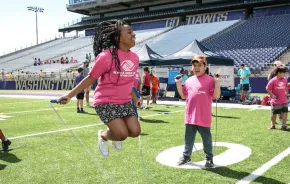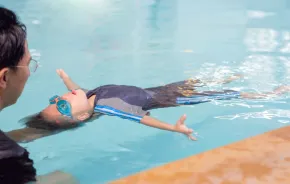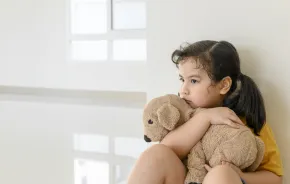
So your 5-year-old has been singing “Let It Go” nonstop since 2013, or plays air ukulele like a miniature Jake Shimabukuro. Or perhaps you’re familiar enough with all the benefits of music literacy — from brain building to learning self-discipline — that you’re determined to provide a music education for your child. Is it time for private lessons?
Choosing the right approach and finding the right teacher for a child’s first instrument lessons may seem overwhelming, particularly if you don’t have a musical background. But if you think you’re ready to make the commitment, here are some key questions to explore before getting started.
Is she ready?
This is perhaps the most challenging question. Just because your child loves to sing or bang on toy instruments doesn’t mean she’s ready to study music formally, although showing consistent interest in an instrument is a good indicator. Music lessons require discipline, patience, a certain physical maturity and — depending on the approach — basic reading ability. Ideally, children should be able to sit still and focus on a task for 10–15 minutes.
What age is best? Aural approaches to music teaching, such as Suzuki (more on this follows) mirror the way children learn to speak and are suitable for younger children around the age of 4 or 5. Notation-based approaches work best with students who can read (or at least recognize the letters A through G) and can manipulate written symbols pretty easily, generally around 8 or 9 years old.
If you’re not sure if your child is ready, you could start with a program such as Music Together’s Big Kids curriculum. Designed for 5- to 7-year-olds, Big Kids incorporates singing and movement to bring students in tune with their main musical instrument — their body.
“We deconstruct songs in our collection down to main pitches. We use percussion instruments and props to help learn musical terms,” says Monica Hernandez, codirector of the Music Together program at Music Center of the Northwest.
Which instrument?
First and foremost, your child should like the sound of the instrument they choose. Many kids start with piano and violin. The piano offers instant gratification at the push of a key, both instruments can accommodate even the smallest hands, and teachers for both are abundant. They also make great “gateway” instruments; I started on violin and transitioned to the double bass as soon as I didn’t have to stand on a chair to play it.
But many other instruments are fine as starters, too — from the ukulele (increasingly popular for its small size and ease of strumming) to child-size guitars and recorders. Even the largest instruments are now available in sizes suitable for the smallest hands and lungs. (Though be warned: If your child takes up the double bass, you might find yourself investing in a bigger car down the road.)
No matter which instrument your child chooses, make sure that it is correctly sized and sounds good. And there is no need to buy: Stores such as Ted Brown have reasonable monthly rental rates ($27–$60, depending on the instrument), and the rental payments can be applied toward the purchase of the instrument.
Which method?

There are a few either/or choices that can help you find the best approach for your child.
Aural or written? There are two general approaches to teaching music to young children: aural and written. In aural-driven methods, students learn by listening and imitating their teacher (and fellow students). Musical notation is introduced only after a student has a firm grasp of his or her instrument. The Suzuki method is perhaps the best-known aural-first approach. Students have individual and group lessons, with the group lessons offering a form of positive peer pressure. One possible downside: Parents are expected to attend lessons, take notes and practice with kids — a commitment that can be difficult to sustain for busy families.
“Written” approaches are probably what most people think of when they think of music lessons, with an emphasis on learning to sight-read. I would argue that reading music results in more independent musicians from the outset: Students can download or buy sheet music to all kinds of songs and work on them on their own. Reading music can also lead more quickly to ensemble playing. The downside is that students trained in the written tradition might have trouble picking up music by ear and improvising.
Classical, jazz or rock? On the one hand, when anyone first starts learning an instrument, certain fundamentals common to all genres have to be mastered: names of strings, how to hold a bow, the names of the piano keys and so on. On the other hand, the last 10 years or so have seen an uptick in less-traditional establishments, such as the School of Rock, which offers a curriculum tailored for budding rockers. But all styles of music require dedication and practice to excel; pop and jazz are in no way easier than classical, nor is classical inherently more tedious and boring.
Fun or fundamentals: You also want to make sure that the approach you settle on focuses on not just songs, but also music and technique. (For example, I would not recommend the “Play Piano in a Flash!” program by Scott Houston, “The Piano Guy,” which forgoes all technique in favor of the end results: Use whatever fingers you want to play the songs.) Most approaches balance technical training with learning songs.
Performance expectations are something else to consider. Is your child interested in performing in public? Some teachers offer a variety of performance activities, ranging from traditional recitals to the “dueling pianos” format used by Off the Wall Music Studio in Wallingford, in which students play and sing while engaging the audience.
Once you’ve honed in on an approach, how do you find a teacher who’s a good fit? J.K. Simmons may have won an Oscar for his portrayal of an abusive music teacher in the movie Whiplash, but his character is hardly representative of the many compassionate teachers out there.
Start by asking everyone you know for teachers and studios they recommend. Once you have identified a couple of candidates, ask if your child can take a sample lesson or two. Look for a teacher who is encouraging but not afraid to critique — who motivates students with patience, good humor and praise when deserved.
Susan Baer, a Suzuki violin teacher/trainer on Whidbey Island, says, “Students are motivated if they feel successful and learning is engaging. Tasks are broken down into small steps, achievement is recognized, and the effort put forth is celebrated.”
As far as cost, many music teachers rely on private lessons as their main source of income, and they like to be able to count on a fixed income every month. Lesson prices in the Seattle area vary greatly, but tend to range from $30 to $50 for a half hour.
After your child has had a few lessons, check in. Ask what she has learned, what was fun, what was challenging and how the teacher helped.
If after a couple of lessons, you feel that the teacher is not a match, be honest. It could simply be that the approach does not meet the needs of you and your child. It’s worth moving on to find a teacher who will encourage your child to work hard, persevere and take pride in his or her accomplishments.
Lessons on practice: Low- and high-tech ways to ease the grind
For many families, the lessons are the easy part — it’s practice that’s the real challenge. Here are some tips:
- In the beginning, short, consistent practice sessions are best, sometimes as little as five minutes a day. This allows the child’s body to adjust to the demands of making music and keeps the practice time within their attention spans.
- Try to have kids practice at the same time every day so it becomes a habit.
And while technology can’t practice for a child, it can help in other important ways:
- Recording lessons via your smartphone voice recorder is a great help at practice time (ask your teacher before recording).
- More private teachers are now offering virtual lessons through video chat programs such as Skype and FaceTime. This can be particularly useful for students in rural areas where private teachers may be hard to find.
- A metronome app such as Tempo ($2.99; iPhone or Android) will help students learn to keep a steady beat.











